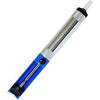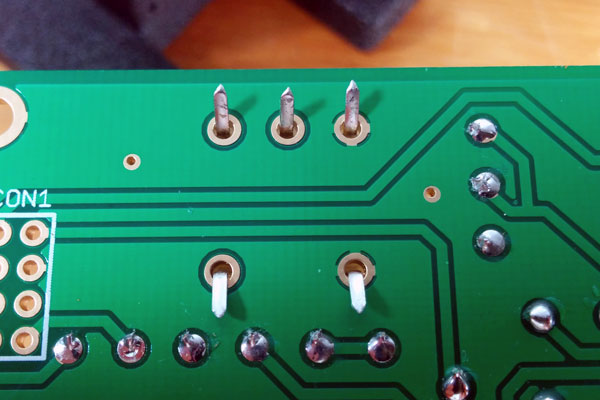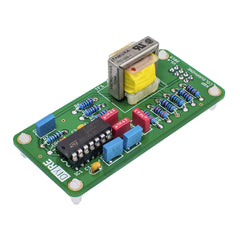Colourphone Assembly Guide
Damaged or Missing Parts All kits and parts are checked before being shipped to you. If something arrives damaged or if your kit is missing a part, please open a support ticket to inquire about a replacement. Missing parts will be replaced at our expense. Damaged parts should be returned for verification. If the part shows signs of use beyond what was necessary to determine that it was damaged, DIY Recording Equipment, LLC reserves the right not to replace the part.
Thank you for purchasing a Colourphone Telephone Distortion Colour!
If this is your first DIY project ever, we recommend reading our Getting Started Guide.
Required Tools
You'll need the tools below to complete this build.

Soldering Iron
We recommend an adjustable-temperature station, such as the $40 Weller WLC100.

Solder
You can use 60/40 "leaded" solder or lead-free. We recommend 60/40 because it flows better and is easier for beginners to use.

Wire Cutters
You'll need a pair of good "snips" for cutting of the excess leads after soldering.
Optional Tools
These tools aren't strictly necessary but can make your build a bit easier.

Multi-Meter
If you find the color bands on resistors a bit hard to read, you can use a meter to sort them with absolute confidence.

Desoldering Pump
If you accidentally solder something in the wrong place, a desoldering pump can save the day.
0. Resistor Calculator
Type in the value of the resistor you need and this tool will show you the corresponding color code.
Place Resistors and Diodes

Identify Resistors
Identify the 10 resistors by measuring them with your multi-meter or by reading their color codes.

Bend and Place the Resistors
Bend the resistors near the body as shown so that they can be easily inserted into the PCB. Now put the resistors in their respective places on the PCB.

Place the Diode
Bend the leads of the diode about 1/8" away from the body and place it in the PCB. Note that the yellow line on the body should correspond to the line on the PCB.

Bend the Resistor and Diode Leads
Bend the leads of the resistors and diode against the bottom of the PCB to keep the parts in place when we flip over for soldering.

Solder the Resistors and Diode
Now solder the resistors and diode to the PCB. Heat each pad and lead for 2-3 seconds, apply a small bit of solder, and continue to heat the pad for another 2-3 seconds. Allow each solder joint 10 seconds to cool before moving on to the next one. The finished joints should be shiny and should have just enough solder to cover the pad entirely.

Trim the Leads
Once all of the solder joints have cooled, use your clippers to trim away the excess leads. Your goal should be to clip as close as possible to the joint without clipping the joint itself.
Place Socket and Capacitors

Place the IC Socket
Next, place the socket for the integrated circuit IC1. Orient the socket so that the semi-circular notch on one end matches that on the PCB.

Fasten the Socket in Place
Fasten the socket with a piece of tape or an alligator clip as shown so that it stays in place for soldering.

Solder the Socket
Solder the socket to the PCB and trim the leads down to the joint.

Place the Capacitors
Next, identify and place the capacitors. The two small, yellow caps are C1 and C2. The three red caps labeled "u1k63" are C3, C6, and C7. The two blue caps labeled "1nJ63" are C5 and C8. And the remaining blue cap labeled "2n2J63" is C4.
The PCB pads for the blue caps are slightly too close together, so you'll have to bend the pins of these caps slighly inward for them to slide easily into the holes.

Solder the Capacitors
Solder and trim the leads of the caps

Place and Solder the Transformer
Place the transformer—that's the big part with 5 leads labeled "Tamura—in the PCB position marked "TF1." Bend the leads against the PCB as shown, solder, and trim.
Place Connectors and IC

Place and Solder the Header
Place the 8-pin header through the bottom of the PCB so that the long, gold pins are pointing away from the PCB. These are the pins that will mate with the Colour Palette. Solder the header—there's no need to trim after soldering.

Insert the Standoffs
Insert the four plastic standoffs into the mounting holes at the corners of the PCB. Insert the locking end into the Colourphone PCB and leave the removable ends to be insterted into your Palette.

Bend the IC Pins
See how the pins of the IC protrude from the body at slightly wider than a 90 degree angle? In order to fit the IC into the socket, we'll need to bend the leads inward a bit.Set the IC on its side and press from the other side to bend all the leads at once. Then flip the IC over and do the same for the other side. When you are done the leads should be perpendicular to the body.

Insert the IC
Set the IC on top of the socket, making sure to align the semi-circular notches. Double check this! Now apply pressure with one or two fingers to press the IC firmly into the socket. Is it really in there? Good, then you're done!
Final Checks
Before you wrap up, check the following things:
-
IC orientation: Does the dot/notch on the IC align with the notches on the socket and PCB?
-
Diode orientation: Do the stripes on the diode match those on the PCB?
-
Resistors: Do all of the resistor positions correspond the chart and/or sorting sheet?
-
Soldering: Is every solder joint shiny and clean? If one is cloudy or misshapen, try reheating it for 8 seconds and adding a tiny bit more solder.
-
Trimming: Are all of the excess leads trimmed down as close to the joint as possible?
All good? Congrats on finishing your build! Have a question or problem? Drop us a line.
Help Us Improve
1
2
3
4
5
6
7
8
9
10


